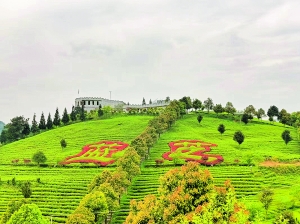Kaiyang reaps benefits from tea industry

An aerial view of the Lanzhi Tea Garden in Kaiyang county, Guiyang. [Photo/Guiyang news network]
In recent years, Kaiyang county in Guiyang, capital of Southwest China's Guizhou province, has promoted the development of the local tea industry and benefited a lot from it.
Kaiyang has been growing tea since the Song and Yuan dynasties (960-1368), and due to its abundant selenium, the tea industry has been flourishing.
The Lanzhi Tea Garden, built in 2008, grows more than 1,000 mu (66.67 hectares) of tea. It has provided over 100 farming households with jobs so far.
The tea garden does not use pesticides or chemical fertilizers, only organic fertilizers, and only uses biological and physical means to control pests. Its good soil allows it to brand its tea as green ecological organic tea.
Another Jinfu tea garden in Kaiyang has grown over 2,000 mu of tea since 2011, creating more than 500 jobs for local people and increasing their annual incomes by over 10,000 yuan ($1,387) on average.
Kaiyang is currently home to more than 170,300 mu of tea plantations, 160,000 mu of which produce more than 10,000 metric tons of dry semifinished tea valued at more than 2 billion yuan annually.
More than 40,000 local farming households have benefited from the development of the tea industry.
To further the industry's development, Kaiyang has provided training for technicians and expanded sales channels.
Guiyang has also made efforts to promote the integrated development of the tea industry and cultural tourism and has already launched a series of boutique tourism routes, such as the Shilihualang Tea Tour Line and the Nanma Tea Tour Line.
Presented by China Daily.
黔ICP备05001922号-3
